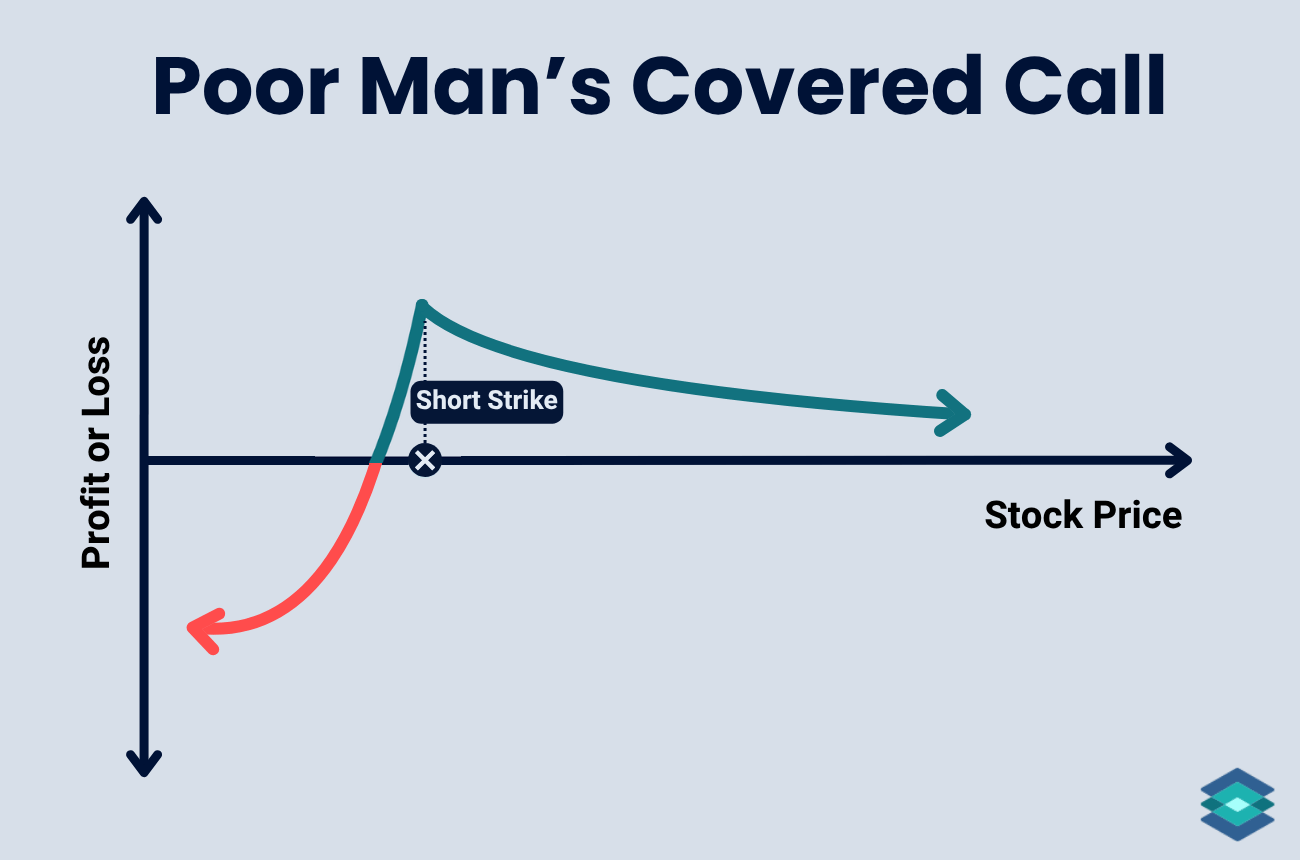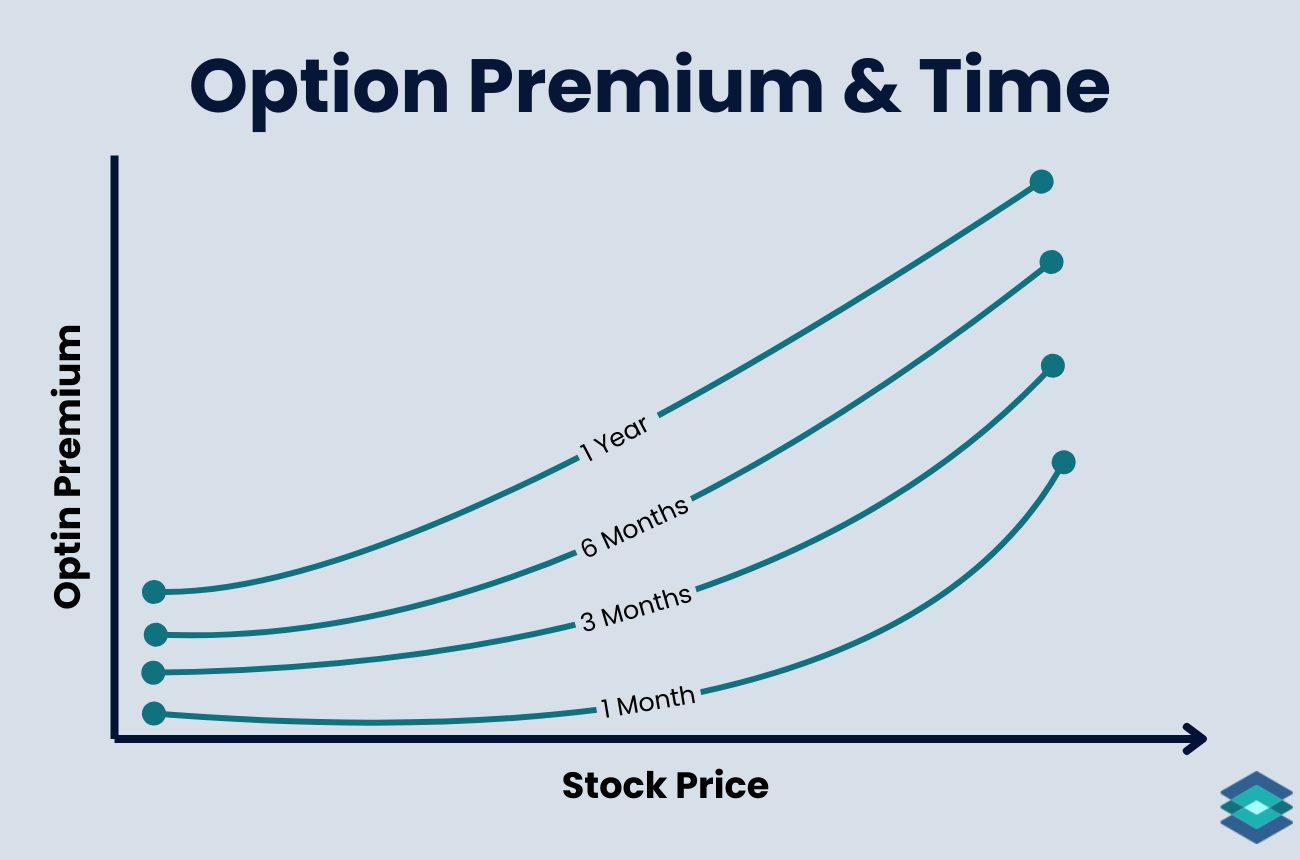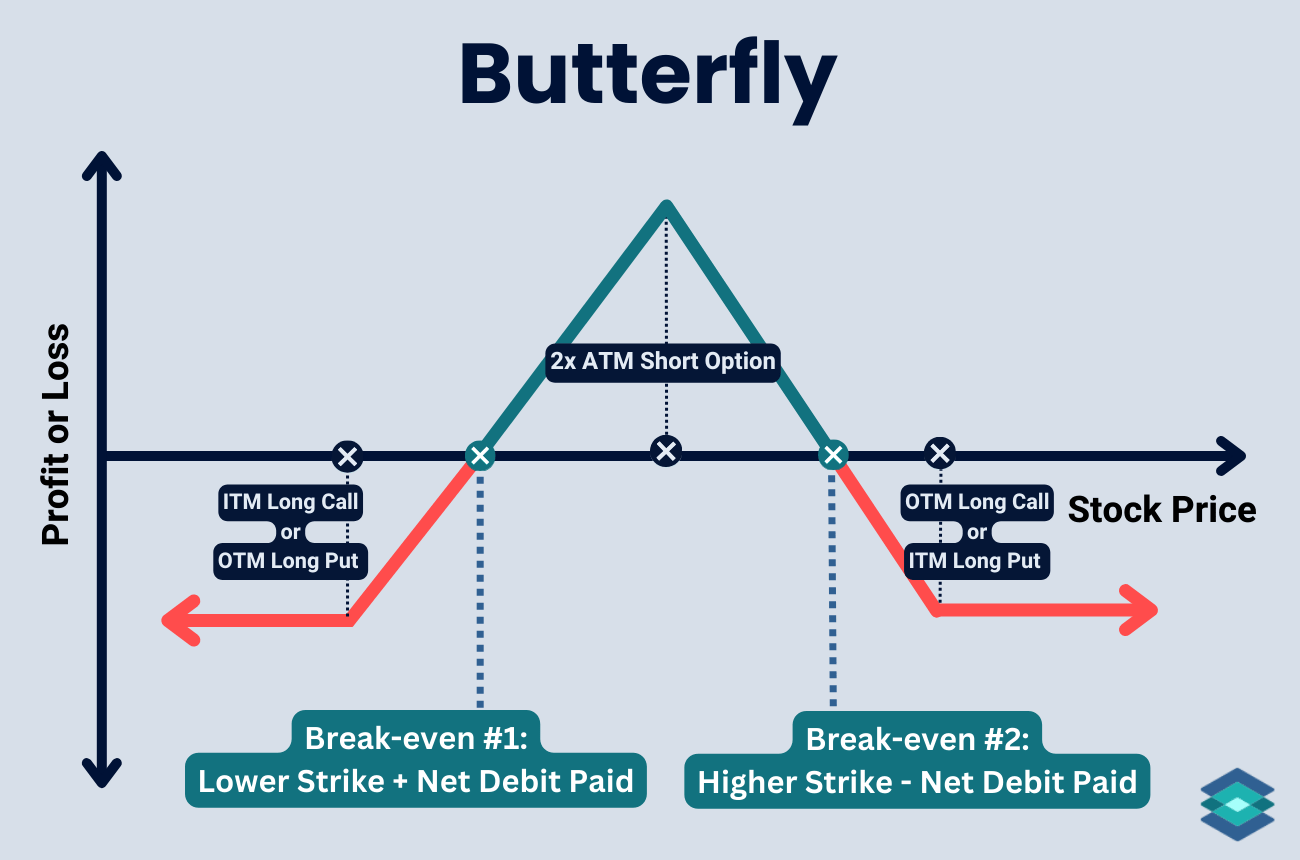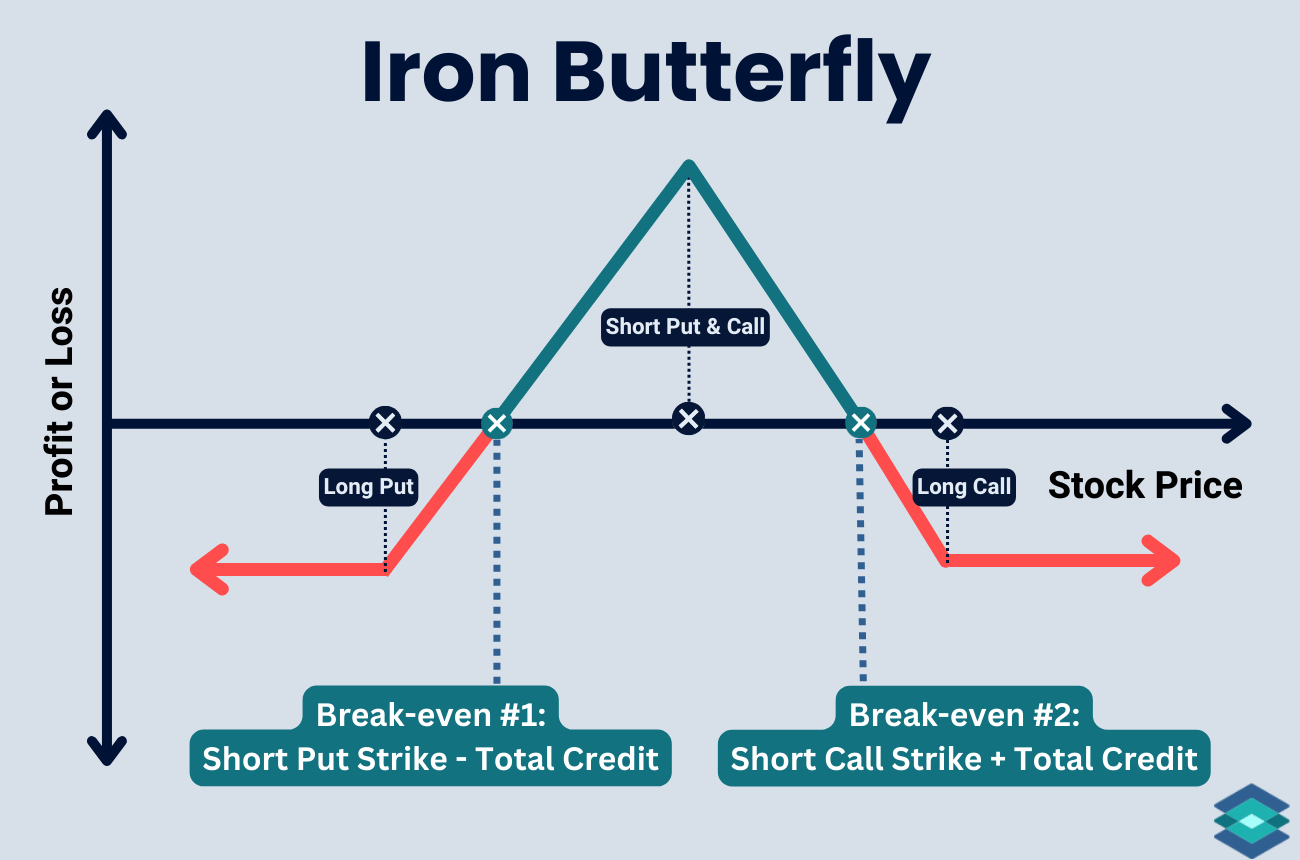Collar Options Strategy: Beginner's Guide
A collar is an options strategy that caps upside but protects downside by combining a covered call with a long put option.

The collar is a defensive options strategy that involves buying 100 shares of stock, selling 1 call, and buying 1 protective put. The long put limits downside losses, while the short call limits your profit potential on the long stock.
Highlights
- Risk: Downside is limited by the long put. You’re protected below the put strike price, minus any net premium paid.
- Reward: Upside is capped by the covered call. You give up gains above the call strike.
- Outlook: Defensive, medium-term hedge. Collars work well when you want to protect gains but keep some upside.
- Time Decay: Theta impact is mild and mostly offsetting, with soem edge on the short call. Collars are best held for a medium time frame.
- Zero-cost collar: Sell the call for enough premium to fully offset the cost of the put, creating downside protection at no extra cost.
🤔If you’re new to options trading, it helps a lot to understand how the covered call and long put option work before moving on to the collar.
Collar Trade Components
Here’s how you build an options collar:
- Buy 100 shares of stock
- Buy 1 out of the money put (protects downside)
- Sell 1 out of the money call (limits upside, generates premium)

If you’re not hedging a pre-existing position, your best bet is to enter the collar in one trade. If you leg in, you’ll be exposed to directional risk. We can see this setup on the TradingBlock dashboard below:

Notice the trade cost here is cheaper than simply buying 100 shares. That’s because the option premium we collect from the call is richer than what we pay for the put.
Keep in mind that when you collect more premium on the call side or pay more on the put side, you change the balance. More income tightens your upside, more cost gives you stronger downside protection.
Outlook: When To Place Collar Trades
- When you want to lock in gains on a long-term stock without selling it right away.
- When you want downside protection but don’t want to pay too much
- When you’re fine capping upside because you don’t expect a huge rally.
- When you’re planning to sell the stock if it passes your short call strike price.
Collar Payoff Profile
Let’s now review the maximum profit, loss, and breakeven for this trade.
Collar Strategy: Max Profit
The max profit on a collar is the difference between the short call strike and your stock cost basis, plus any net premium (in this case, zero).
- Max Profit = Short Call Strike – Stock Cost Basis ± Net Premium
For example, say you own XYZ at 100, buy a 95 put for 2, and sell a 105 call for 2. Since the call premium collected equals the put premium paid, this is a zero-cost collar.
Trade details:
- Stock Cost Basis: 100
- Long Put Strike: 95
- Short Call Strike: 105
- Net Premium: 0 (call covers put)
- Max Profit: 5 per share (105 call strike – 100 stock cost)
Your best outcome is the stock closes right under the short call strike (105). You keep all the stock gains up to 105, the call expires worthless so you keep the shares, and the put cost was covered. If the stock closes above 105 you’ll get assigned and sell at 105.

Collar Strategy: Max Loss
The maximum loss on a collar is limited by the long put strike, minus any net premium, and the stock’s cost basis.
- Max Loss = Stock Cost Basis – Long Put Strike ± Net Premium
Using the same XYZ trade:
- Stock Cost Basis: 100
- Long Put Strike: 95
- Short Call Strike: 105
- Net Premium: 0
- Max Loss: 5 per share (100 stock cost – 95 put strike)
If XYZ drops below 95, the put protects you. Your worst case is selling at 95, locking in a 5-point loss. The collar puts a floor under your shares without extra cost. We can see this below:

Collar Strategy: Breakeven
To break even on a collar, adjust your stock cost by the net option premium.
- Breakeven = Stock Cost Basis ± Net Premium
Using our example:
- Stock Cost Basis: 100
- Net Premium: 0 (call covers put)
- Breakeven: 100
If XYZ remains at $100 at option expiration, the position breaks even because the options offset each other, and the stock is held at its cost. If the stock falls below 100, the long put limits further losses.
We can see this here:

Collar: XLF Trade Example
In this trade example, we’re going to ‘collar’ a long stock position in XLF (Financial Select Sector SPDR Fund). As I mentioned earlier, I usually add a collar to an existing equity position. For simplicity and to illustrate the process, we’ll buy the stock, sell the call, and buy the put all at the same time.
In this trade, I want a bit more downside protection, so I’ll buy a put that’s slightly closer to the money. This will skew the trade, and it won’t be a zero-cost collar, but close. I also want to give my trade some time to work, so I will be looking for an expiration cycle around 30 days out.
Let’s head to the TradingBlock dashboard to find our options on the options chain:

We’ve decided to sell the 55 call and use some of that premium to purchase the 50 put. We will also purchase 100 shares of XLF at 52.46. Remember that an option contract represents 100 shares of stock, so this is the quantity of stock we will need to buy for a one lot.
Take note: it’s always important to send option orders at the “mid-point”, which is simply the price between the bid and ask. If you don’t get filled immediately (and want to), walk your order up in penny or nickel increments until you do. And if you can’t get a decent fill, skip the trade.
We’ll assume we got filled at the mid-point on this one, which means we paid a debit of 52.63:

XLF Trade Details
We sent and got filled on our XLF collar. Let’s now take a closer look at the trade details:
- Shares Bought: 100 XLF @ 52.46
- Sell 1 Call: Strike 55 @ 0.33 mid
- Buy 1 Put: Strike 50 @ 0.50 mid
- Net Debit Paid: 52.46 (stock) + 0.50 (put) – 0.33 (call) = 52.63 total cost per share
- Breakeven: 52.63
- Max Profit: 55 call strike – 52.63 cost = 2.37 per share ($237 total)
- Max Loss: 52.63 cost – 50 put strike = 2.63 per share ($263 total)
- Profit Zone: Max gain if XLF closes at or above 55; protection kicks in below 50
- Risk/Reward: Risking $263 to make $237 per 100 shares
Let’s next examine a couple of trade outcomes.
XLF Collar: Ideal trade Outcome
In this trade outcome, XLF rallied slightly and closed just below our short call strike price of $55. Here’s where we ended:
- XLF Price: $52.46 → $54.80 ⬆️
- Expiration: 39 days → 0
- Shares Bought: 100 @ $52.46
- Sell 55 Call: $0.33 → expired worthless
- Buy 50 Put: $0.50 → expired worthless
- Net Cost Basis: $52.63 (stock + put – call)
- Net Gain: $2.17 per share ($217 total)
- Percent of Max Profit Realized: ~92%
- All-In Result: Shares rose, hedge not needed, profit locked in just under the capped level
The collar capped upside at 55, but XLF stayed just below this price, so the call expired worthless, and shares remained intact. This was almost the ideal outcome.
Since the stock stayed well above the protective strike at 50, the put wasn’t needed. The trade captured the move from the adjusted cost basis to $54.80, making a $2.17 per share gain ($54.80 – $52.63).
If the stock had been owned outright, the return would have been slightly higher at $2.34 per share since there would be no hedge cost. However, considering we had a relatively inexpensive hedge in place (0.17), this worked out great for us.
Let’s next see how this trade played out in real time:
XLF Trade: Under The Hood

- Time decay worked for us: The short call lost value as days passed, which is exactly what you want when selling premium.
- Upside stayed capped: The stock price stopped just under the call strike, locking in gains without triggering assignment.
- Net result: This hedge cost only 17 cents per share but gave peace of mind while we stayed invested.
As I mentioned, this was almost the ideal trade outcome. Let’s now examine a scenario where our long put kicks into gear!
XLF Collar: Less Ideal Outcome
In this trade outcome, XLF plummeted in value, putting our long put to work. Here’s where things ended:
- XLF Price: $52.46 → $46.00 ⬇️
- Expiration: 39 days → 0
- Shares Bought: 100 @ $52.46
- Sell 55 Call: $0.33 → expired worthless
- Buy 50 Put: $0.50 → $4.00 at expiration (in the money)
- Net Cost Basis: $52.63 (stock + put – call)
- Net Loss: $52.63 – $50 = –$2.63/share
In this trade outcome, our long put kicked in at XLF $50, protecting us once the stock dropped below that level. As XLF slid past the put strike, every dollar down was offset 1:1 by gains in the put’s value, capping our downside.
Since our long put closed in the money, it would have been exercised, forcing us to sell our shares at $50. Our short call expired worthless, so our net position in XLF would be flat the next trading day.
XLF: Under the Hood
Here’s how this trade played out over time:

This chart illustrates how the collar’s protective side performs when the market declines. As XLF drifted lower, the long put steadily gained value while the short call flatlined and expired worthless. The purple line shows how the net collar value held steady once the put kicked in, locking the final exit near the $50 strike.
Without the put, this move from $52.46 to $46.00 would result in a $6.46 loss per share ($646 total). Instead, the put’s intrinsic value offsets those losses dollar for dollar below $50, capping the real loss at $2.63 per share ($263 total). The short call premium helped offset the hedge cost, keeping the net cost basis in line.
Choosing Your Option Strikes
Select strikes that fit with your outlook and risk tolerance. For a zero-cost collar, many traders keep both the short call and long put around 5% out of the money. If you want more downside protection and do not mind paying more premium, you might buy your put 3% out of the money and sell the call 5% out of the money.

A tight collar keeps the put closer to the stock price and the call lower, which tightens risk but limits upside sooner. A loose collar gives the stock more room to run before the call caps gains, but leaves more downside loss potential if the stock drops.
Time Decay (Theta) and Collars
A collar trade is both long and short an option, so you have long and short theta working at the same time. If you’re running a zero-cost collar, your long put and short call are usually about the same distance out of the money, which keeps your net position’s theta close to neutral, but not exactly flat.
Out of the money calls generally carry more extrinsic value (time value) than puts do in most markets. Because of this, your net theta will usually be slightly short, meaning time decay works in your favor overall.
We can see this skew on the TradingBlock dashboard below:

Collars: Choosing Your Expiration
You want to give your options enough time to work when trading collars. The main reason for placing this trade is to create a low-cost way to hedge downside risk. On the put side, you need enough time for meaningful protection. You do not want to collar with just a few days to expiration unless you are hedging a specific event like earnings or economic data.
On the call side, you also need time to collect real premium. If you sell your call too close to expiration, there will not be much premium to collect at all.
I find the sweet spot for a collar is in the 30 to 60 day range. This keeps your hedge useful, the short call worth selling, and gives you time to manage or roll the trade if needed.
Collars and Implied Volatility
Implied volatility has a direct impact on the cost of your collar. When implied volatility is high, the put side of your collar gets more expensive because traders expect bigger moves to the downside.
At the same time, your short call will collect more premium, too, which can help offset the higher cost of the put. This is why collars often work best when volatility is elevated but not extreme. You get meaningful downside protection without overpaying.
.png)
Managing a Collar
The collar involves two options contracts, so some active management may be required on your behalf. Here are a few tips:
- Avoid call assignment: If your short call is in the money and you still want to hold the shares, roll the call up to a higher strike or out to a later expiration to lift your upside cap.
- Avoid put auto exercise: If your long put is in the money and you don’t want to sell the shares, roll it further out of the money or to a later expiration to extend downside protection.
- Stay proactive: Manage rolls before expiration to stay in control and avoid unexpected assignment or auto exercise.
Collars and The Greeks
In options trading, the Greeks are a set of risk metrics that help estimate how an option’s price will respond to changes in key market variables. Here are the five most important Greeks to know:
- Delta – shows how much the option price changes for a $1 move in the stock.
- Gamma – shows how much delta shifts when the stock moves $1.
- Theta – shows how much the option loses in value each day from time decay.
- Vega – shows how much the option price changes for a 1% change in implied volatility.
- Rho – shows how much the option price changes for a 1% change in interest rates.
And here is the relationship between collars and these Greeks:
⚠️ Collars involve defined risk and limited upside, but still require a clear understanding of how options work. This strategy may not be suitable for all investors. Commissions, fees, and slippage can significantly impact trade outcomes, none of which are reflected in the examples above. Read The Characteristics and Risks of Standardized Options before trading options.
FAQ
An options collar is an option strategy that combines three parts: 100 shares of long stock, one short call, and one long put. The goal is to limit downside risk without completely giving up upside.
A covered call is just 100 shares of stock plus a short out of the money call. A collar adds a long put for extra downside protection. Because of this put, the collar gives you more insurance against big losses, but you pay for it by giving up some upside and paying a net premium if the short call does not fully cover the put cost.
Say ABC is trading at $100 per share. You want protection at $95, so you buy a 95 put for $2. That alone is a protective put. To make it a collar, you sell a 105 call for enough premium to cover all or part of that put cost (zero-cost collar). This caps your upside above $105 but limits your loss below $95.
The maximum loss on a collar is the difference between your stock cost basis and the long put strike, adjusted for any net premium paid or collected. This sets a clear floor under your position so you know your worst-case outcome up front.
A covered call is when you sell a call option against 100 shares of stock you already own. Because you hold the shares, your max profit is the premium collected plus any gains up to the strike. Your max loss is the same as owning the stock outright minus the premium collected and occurs if the stock falls to $0.
The maximum gain on a long put is the strike price minus the premium paid, assuming the stock drops to zero.










